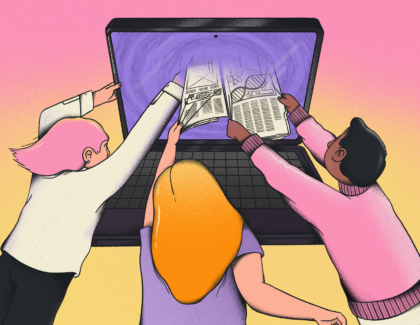Sign up for the daily CJR newsletter.
Over the Fourth of July weekend last year, with the pandemic raging in the US, then-President Trump gave a pair of speeches in which he downplayed the threat of the virus and played up the threat of rampaging left-wing mobs; swathes of the press characterized his rhetoric as “dark and divisive,” implicitly situating it, as I wrote at the time, in stark contrast to America’s post-revolutionary trajectory of shared purpose. Over the Fourth of July weekend this year, with the pandemic having waned thanks to a speedy rollout of effective vaccines, President Biden gave a speech that was altogether more palatable to the pundit class. “History tells us that when we stand together, when we unite in common cause, when we see ourselves not as Republicans or Democrats but as Americans, there is simply no limit to what we can achieve,” he said. “Today, we see the results of unity of purpose. For together we are beating the virus.” CNN and MSNBC carried the speech live. Fox opted not to, but did show it later.
It wasn’t just Biden’s speech—a number of outlets and TV shows used the Independence Day holiday itself as a peg to recenter the pandemic in the national conversation. Some of the coverage had a sweeping, retrospective quality. “We have gone from the leading example among industrialized countries of how not to handle a pandemic,” Chuck Todd said, at the top of Meet the Press, “to a nation tentatively declaring its independence from the virus as other countries face renewed lockdown.” Not that the retrospection meant finality. Biden’s warning that the pandemic isn’t yet over trickled down through news stories and segments. And a lot of the coverage dwelled on the skunk at the White House garden party: the Delta variant, a more transmissible strain of COVID-19 already dominant in many countries, is now gaining a foothold across the US. While the hopeful allusions to Independence Day were often national in scope (and maybe even nationalistic), coverage of the variant emphasized regional disparities in vaccination takeup within the US, and international disparities in vaccine access. At the top of ABC’s This Week, Martha Raddatz reported on worrying levels of vaccine hesitancy in West Virginia; on Meet the Press, Todd interviewed Dr. Seth Berkley, of the international vaccine alliance COVAX. “We have to keep in mind that this may not be the last variant,” Berkley said, of the Delta variant. “We’re not really there yet in terms of getting the coverage we need.”
New from CJR: “I Felt Set Up to Fail”
As media attention has grown along with the prevalence of the variant in the US, there has been some debate as to the proper proportion between the two. Last week, CNN’s Oliver Darcy acknowledged that the variant is “a serious story that warrants serious coverage,” but argued that the press should be careful to situate it within “the big picture about the state of the pandemic here in the US,” which is “quite good”—as long as you’re vaccinated. Dr. James Hamblin, a science writer, told Darcy that the media is apt to cover potential problems over things broadly being fine, adding that hypothetical alarmism about the variant threat, in the absence of actionable information, risks causing reader fatigue; Dr. Jonathan Reiner, a professor of medicine at George Washington University, argued that “the big story” of this moment “is the success story” of mass vaccination and American resilience. Not every expert agrees, though. Dr. Leana Wen, also of GWU, told Darcy that while vaccinated people “are generally fine to go about their normal lives,” the press has been partially responsible for giving unvaccinated people “the false impression that the pandemic is over.” More broadly, while vaccines are effective against the variant, questions remain about the precise extent of that effectiveness.
For now, a central disagreement here seems to be the extent to which COVID coverage should focus on people who are vaccinated as opposed to people who aren’t. This is an interesting debate, echoing broader questions around the media’s duties to accuracy and actionability, and the balance between the two. It’s also, at this stage of the pandemic, a very American debate, reflecting a country that has both a lot of vaccines to distribute and a lot of people who aren’t willing to take one, often (though by no means always) for explicitly political reasons. Coverage in other countries where the Delta variant is spreading looks different, reflecting a lack of access to vaccines and/or more immediately concerning levels of viral spread.
The United Kingdom, for example, is quickly becoming a closely watched international story due to the rapid spread of the variant there; the country has fully vaccinated many of its most vulnerable residents, but demand continues to outstrip supply, and cases have surged (though, crucially, hospitalizations and deaths have not to the same degree). Perhaps as a consequence of these trends, British media coverage of the variant has focused less on the gulf between those who have been vaccinated and those who don’t want to be, and more on collective risk—a phenomenon that came into sharper focus yesterday when Boris Johnson, the prime minister, effectively confirmed that the majority of remaining coronavirus restrictions will end in two weeks. The political right generally supports an end to restrictions, while many on the left see it as reckless with cases rising so sharply. This morning, that divide was on full display in the pages of the nation’s newspapers, which are, collectively, a reliable bellwether of partisan sentiment. The right-wing Daily Mail took aim at “gloomy scientists,” while The Sun pictured Johnson standing on a giant England flag with the headline “FREE LIONS,” a reference to England’s (currently successful) soccer team, whose badge features three lions. Left-leaning papers, by contrast, painted the reopening decision as a gamble. The left-leaning Daily Mirror went with the headline “MASKING FOR TROUBLE,” a reference to Johnson’s decision to scrap mask mandates.
Many factors here, including the opinionated orientation of leading newspapers, are specific to the UK. But the sweeping questions underpinning the coverage there—What constitutes the end of the pandemic? What is an acceptable daily case rate? What about deaths? What does normal look like?—are universal. In the US, raising them in the context of Independence Day resulted, at least in much topline framing, in a narrowness of focus and analogy—Give me liberty or give me Delta—when it may have been more fruitful to use a wider lens. The Delta variant arriving in the US is an important story; so, too, is what America could send out to a world in which it is no longer a plucky underdog. Reiner is right that the development of the vaccines constitutes a success story, but their international distribution, so far, does not. These are all global questions and challenges. Their answers are interdependent, not independent.
Below, more on the pandemic:
- Distrust: Writing for Undark, Timothy DeLizza makes the case that media narratives around vaccine hesitancy in Red States reveal “a remarkable lack of curiosity and empathy regarding the complexity underneath these beliefs.” Conservative white vaccine skeptics are typically presented as anti-science conspiracy theorists, but poor white people, in particular, have legitimate reasons to mistrust the medical system—not least its recent driving role in the opioid epidemic, DeLizza argues. “The suspicions felt in Black and Brown communities likely aren’t all that different from the suspicions felt by White people,” he writes. “In each case, focusing on outlandish vaccine conspiracy theories glosses over genuine underlying concerns.”
- Israel: The Delta variant is increasingly causing concern in Israel, despite the high level of vaccination in that country; yesterday, health officials said that the Pfizer-BioNTech vaccine has only proven sixty-four percent effective against catching the variant there, though they also said that it remains more than ninety percent effective against hospitalization and severe illness. Some health experts have challenged the methodology behind the health ministry’s analysis. A British study previously found the Pfizer vaccine to be eighty-eight percent effective at preventing symptomatic illness. Haaretz has more.
- Overlapping stories: COVID cases may be at low levels in the US, but the pandemic continues to intersect with other major news stories: on Friday, for instance, the Miami-Dade fire chief confirmed that six firefighters assisting with the rescue effort at the collapsed condo in Surfside, Florida, had tested positive for COVID, and been taken off the job. “Unfortunately,” the chief said, “this is another challenge.” The Miami Herald has more. On Sunday night, the portion of the condo that was still standing was demolished, amid fears of a further collapse as a tropical storm moved in.
Other notable stories:
- Breaking this morning: Nikole Hannah-Jones, a journalist with the New York Times Magazine, will join Howard University in the summer as its Knight Chair in Race and Journalism, a new, tenured position. Hannah-Jones was recently offered a similar position at the University of North Carolina at Chapel Hill, but the board of trustees initially refused to consider her tenure application amid a conservative backlash over Hannah-Jones’s involvement with the 1619 Project, a major Times Magazine initiative that centers slavery in the American story; the board voted last week to award tenure, but Hannah-Jones will now join Howard instead. The journalist and writer Ta-Nehisi Coates is also joining Howard’s faculty. The Washington Post has more details.
- Kevin Draper, of the Times, reports on the “explosive fallout” at ESPN after Rachel Nichols, a white NBA reporter, complained, on a private phone call last year, that Maria Taylor, a Black colleague, had been treated preferentially because the network was “feeling pressure” over its “crappy longtime record on diversity.” Nichols accidentally filmed her remarks on a feed that was accessible to other staffers, one of whom, Kayla Johnson, a producer, shared the footage with Taylor. Nichols appears not to have been punished for her remarks. Johnson, who is Black, was suspended, and has since left ESPN; Taylor’s contract is nearly up and it’s “increasingly likely” that she won’t renew it.
- A week ago, the Detroit News reported that a local bookie was once accused of cheating the golfer Phil Mickelson. On Wednesday, a spokesperson for Mickelson—who was about to tee off in a tournament in the city—claimed that the article, while true, had been timed to “embarrass” Mickelson; on Thursday, Mickelson himself called it “opportunistic and selfish,” and indicated that he wouldn’t play in Detroit in future “with that type of thing happening.” On Friday, he reversed his stance—on the condition that fifty thousand people sign a petition pledging to perform an act of kindness. The News has more.
- Ben Smith, of the Times, reports that the tennis star Naomi Osaka—who dropped out of the French Open in May after declining to fulfil her media duties, citing mental-health grounds—is now engaging with the press again, but on her own terms: she’s written a cover essay for Time, and is guest-editing an edition of Racquet, a literary tennis magazine. Osaka’s media relations matter, Smith writes, “because sports, and the media that covers them, are often leading indicators of the direction in which we’re all headed.”
- The insurrection at the Capitol was six months ago today. The Washington Post’s Devlin Barrett reports that, ahead of the anniversary, the Justice Department has begun to arrest “a new category of alleged criminals—those who attacked reporters or damaged their equipment as journalists documented the violence.” As of Thursday, at least five people had been detained on such charges in the span of little more than a week.
- Last week, the National Catholic Reporter, a religious newspaper based in Kansas City, moved to divest its endowment from fossil-fuel companies. Renée Roden reports, for Religion News Service, that while faith-based organizations—many of them Catholic—have been in the vanguard of fossil-fuel divestment, their number has so far included “more religious orders, universities, and dioceses than media organizations.”
- Yesterday, anti-LGBTQ agitators in Tbilisi, the capital of Georgia, attacked journalists with bottles and sticks, and accused them of producing propaganda. Around twenty reporters were injured; according to the AP, a local media group “published a photo of a man it said was a local TV journalist being pulled away from the demonstration in a headlock by an Orthodox priest.” A planned march for LGBTQ rights was cancelled.
- Last week, Diego Charles, a journalist in Haiti, was shot and killed outside his home; Marie Antoinette Duclair, an opposition activist, was also shot and killed nearby, having reportedly driven Charles home from a meeting. A senior police official suggested that Charles and Duclair were random victims of a broader spate of shootings that followed the earlier murder of a police officer, but others suspect a political motive in their cases.
- And the Home News Tribune, a newspaper in New Jersey, last week amended an error that appeared in its pages more than seventy-five years ago. Len Ferman, a newspaper-archive enthusiast, was searching old copies for a reference to his father when he noticed an edition that had mixed up the names of a cousin and her friend. Len wrote to the Home News Tribune requesting a correction, and the paper obliged.
ICYMI: Donald Rumsfeld’s press, then and now
Has America ever needed a media defender more than now? Help us by joining CJR today.







